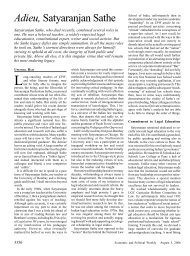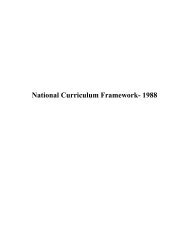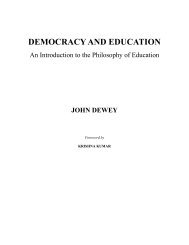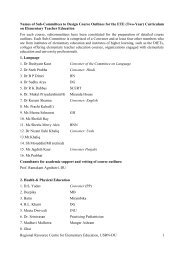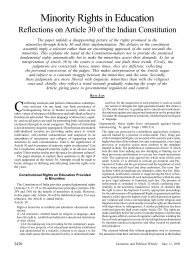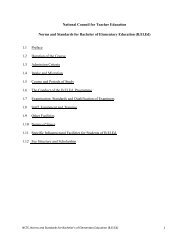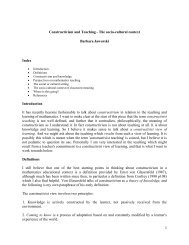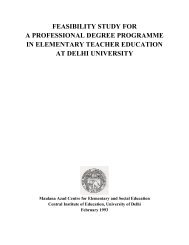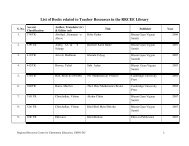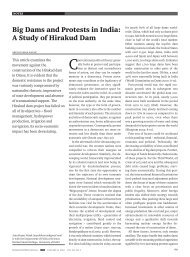Identity politics and the annihilation of castes - Eledu.net
Identity politics and the annihilation of castes - Eledu.net
Identity politics and the annihilation of castes - Eledu.net
Create successful ePaper yourself
Turn your PDF publications into a flip-book with our unique Google optimized e-Paper software.
<strong>Identity</strong> <strong>politics</strong> <strong>and</strong> <strong>the</strong> <strong>annihilation</strong> <strong>of</strong> <strong>castes</strong>A N A N D T E L T U M B D EIDENTITY, one’s sense <strong>of</strong> self <strong>and</strong> its persistence, as shaped through ascriptive <strong>and</strong> subjectiveprocesses, is natural to humans as social beings. <strong>Identity</strong> <strong>politics</strong>, however, is not natural. It isarticulated through a persistent sense <strong>of</strong> discrimination <strong>and</strong> oppression, ei<strong>the</strong>r innate or induced,along <strong>the</strong> axis <strong>of</strong> ‘defining’ one identity from among many. <strong>Identity</strong> <strong>politics</strong> thus necessarilyveers towards becoming essentialist. Consequently, ra<strong>the</strong>r than underst<strong>and</strong>ing oneself as havingheterogeneous <strong>and</strong> multiple identities, people are provoked to support <strong>the</strong> <strong>politics</strong> based on aparticular identity.Although ‘identity <strong>politics</strong>’ can draw on intellectual precursors from Mary Wollstonecraft(1759-1797) to Frantz Fanon (1925-1961) – writers who have actually used this specificphrase 1 – it became more pronounced in <strong>the</strong> second half <strong>of</strong> <strong>the</strong> twentieth century through largescalepolitical movements (second wave feminism, Black civil rights in <strong>the</strong> U.S., gay <strong>and</strong>lesbian liberation, <strong>and</strong> <strong>the</strong> American Indian movements) which were based on claims about <strong>the</strong>injustices done to particular social groups. The specific discourse with its contemporary baggagehas gained prominence only in <strong>the</strong> last twenty years. These social groups highlighted <strong>the</strong>iridentity in response to <strong>the</strong> experience <strong>of</strong> cultural imperialism (including stereotyping, erasure, orappropriation <strong>of</strong> one’s group identity), violence, exploitation, marginalization, or humiliation byo<strong>the</strong>rs. 2There has been considerable scholarly interest in identity <strong>politics</strong>, highlighting its egalitarian <strong>and</strong>preservationist dimensions. The protagonists tend to see it in positive light because <strong>of</strong> itsdemocratizing potential. It may, however, be noted that <strong>the</strong> specific dimensions <strong>of</strong> identity<strong>politics</strong> come forth, not as its generic attribute but in <strong>the</strong> specific context <strong>of</strong> a particular identity.The focus <strong>of</strong> this essay being <strong>annihilation</strong> <strong>of</strong> caste, it deals with <strong>politics</strong> based on caste identity,particularly by Dalits, who being <strong>the</strong> worst victims <strong>of</strong> <strong>the</strong> caste system <strong>and</strong> sans any stake in it,were expected to be <strong>the</strong> torch-bearers in <strong>the</strong> struggle for <strong>annihilation</strong> <strong>of</strong> caste.Caste is considered as constituting <strong>the</strong> basic identity <strong>of</strong> people in <strong>the</strong> Indian subcontinent.Classically, it draws upon a hierarchical notion <strong>and</strong> a corresponding association <strong>of</strong> rights <strong>and</strong>obligations. Caste thus formed a continuum ranging from <strong>the</strong> notional superior-most Brahminsub-caste to <strong>the</strong> inferior-most untouchable caste, <strong>the</strong> precise identity <strong>of</strong> which would beimpossible to determine. This haziness <strong>of</strong> <strong>castes</strong> is <strong>the</strong> result <strong>of</strong> <strong>the</strong>ir sheer numbers as well as<strong>the</strong>ir dynamism. Caste, contrary to its commonplace notion, is not a static category, <strong>and</strong> hasbeen constantly evolving through splits <strong>and</strong> mergers, in turn giving birth to new <strong>castes</strong> which,according to <strong>the</strong>ir material strength, stake claim to a higher ritual position vis-à-vis o<strong>the</strong>r <strong>castes</strong>in <strong>the</strong>ir respective locale. Likewise, geography determines <strong>the</strong> varying modes <strong>of</strong> living <strong>of</strong>people, which also made a difference to <strong>the</strong> social position <strong>of</strong> different <strong>castes</strong>. Caste thusconstitutes a lifeworld <strong>of</strong> <strong>the</strong> people in <strong>the</strong> subcontinent with fluid boundaries.
This lifeworld was defined <strong>and</strong> concretized by <strong>the</strong> British colonial regime through <strong>the</strong>establishment <strong>of</strong> a modern state in India with its concomitant reliance on techniques <strong>of</strong>measurement. The decennial censuses instituted from 1872 as a part <strong>of</strong> this process enumerated,codified <strong>and</strong> ranked <strong>the</strong> <strong>castes</strong>, shaping <strong>and</strong> solidifying identities <strong>of</strong> people in a manner thatcould be used by <strong>the</strong> colonial state. As Chakrabarty observes, <strong>the</strong> colonial scheme reconstituted<strong>the</strong> meaning <strong>of</strong> ‘community’ or ‘ethnicity’ <strong>and</strong> gave Indians an important political message thatwould involve <strong>the</strong>m into negotiating with <strong>the</strong> state for <strong>the</strong>ir betterment. 3 Expectedly, it unleasheda new dynamic <strong>of</strong> caste mobilization, making representations to <strong>the</strong> colonial state necessary forgetting a higher rank than what was accorded to <strong>the</strong>m in <strong>of</strong>ficial records.Initially, <strong>the</strong>se mobilizations took <strong>the</strong> form <strong>of</strong> caste associations. The innate aspirations <strong>of</strong> <strong>castes</strong>to be ranked higher in <strong>the</strong> caste hierarchy manifested in constructing a self-image <strong>of</strong> high originbased on myths. Every caste, including <strong>the</strong> untouchable <strong>castes</strong>, had such myths that showed itsorigins as emanating from Brahmins, but which had fallen as a result <strong>of</strong> <strong>the</strong> intrigues <strong>of</strong> highcaste people. It thus externalized <strong>the</strong> blame for its current state. Even as <strong>the</strong>se <strong>castes</strong> accused <strong>the</strong>Brahmins <strong>of</strong> being <strong>the</strong> cause <strong>of</strong> <strong>the</strong>ir degradation, <strong>the</strong>y did not discard <strong>the</strong> ritual framework butra<strong>the</strong>r sought to emulate <strong>the</strong>ir customs, rituals, ideology <strong>and</strong> way <strong>of</strong> life, a process which cameto be known as sanskritization.When <strong>the</strong> British adopted policies <strong>of</strong> compensatory discrimination in terms <strong>of</strong> reservations <strong>of</strong>seats in <strong>the</strong> bureaucracy <strong>and</strong> provincial assemblies while extending self-government to <strong>the</strong>natives, <strong>the</strong> numbers game became important <strong>and</strong> new groups began to form on <strong>the</strong> basis <strong>of</strong>resentment against <strong>the</strong>ir non-representation. This fur<strong>the</strong>r fostered <strong>the</strong> interrelated processes <strong>of</strong><strong>the</strong> formation <strong>of</strong> caste federations. It gave a fillip to caste mobilization to enhance <strong>the</strong>ir numbers(to claim higher representation) <strong>and</strong> in <strong>the</strong> process began assimilating <strong>castes</strong> with looseboundaries. The aim behind this amalgamation <strong>of</strong> <strong>castes</strong>, however, was purely political.With development in <strong>the</strong> means <strong>of</strong> communication, some <strong>castes</strong> seized <strong>the</strong> opportunity forhorizontal integration, bringing about a pan-Indian caste-unification. This process, eulogized bysome sociologists as ethnicization, 4 basically transcended <strong>the</strong> ‘classical’ caste boundaries <strong>and</strong>brought <strong>the</strong> collective to bear a new ‘ethnic’ identity. It represented a fusion <strong>of</strong> <strong>castes</strong>, <strong>and</strong> thusexp<strong>and</strong>ed endogamy. Scholars saw in this ethnicization <strong>of</strong> caste a potential to bring aboutpositive social change, since it imparted a new identity, which apparently ignored castedifferentiation<strong>and</strong> grouped <strong>the</strong>m into larger units, albeit based on caste.This process <strong>of</strong> ethnicization reached its radical high point in <strong>the</strong> non-Brahmin movementlaunched by Jyotiba Phule in Maharashtra <strong>and</strong> later, in <strong>the</strong> Dravidian movement <strong>of</strong> Periyar inTamil Nadu. It was basically catalyzed by <strong>the</strong> new ideas coming from European missionaries,which were propagated in schools, <strong>and</strong> eventually culminated in <strong>the</strong> <strong>the</strong>ory <strong>of</strong> an ‘Aryan race’.Based on a study <strong>of</strong> <strong>the</strong> Indo-European linguistic family, William Jones in 1792 had invoked anotion <strong>of</strong> common, original race whose branches had migrated towards Europe <strong>and</strong> India. Thisnotion was fur<strong>the</strong>r developed during <strong>the</strong> mid-19th century by German Indologists such as AlbertWeber, R. Roth, A. Kuhn <strong>and</strong> J. Mohl, constructing <strong>the</strong>ories <strong>of</strong> a ‘Sanskritic race’ <strong>and</strong> ‘Vedic
people’. When <strong>the</strong>se ideas reached India <strong>the</strong>y were immediately picked up by <strong>the</strong> likes <strong>of</strong> Tilak<strong>and</strong> Dayan<strong>and</strong> Saraswati for Hindu revivalism, arousing self-esteem among Hindus that <strong>the</strong>ywere <strong>the</strong> superior people who once ruled <strong>the</strong> world. 5These very ideas were used by Phule for an entirely opposite purpose. He constructed <strong>the</strong> ethnicidentity <strong>of</strong> bahujan (shudra-atishudra), castigating Brahmins as invaders who enslaved <strong>the</strong>natives, <strong>and</strong> thus provided <strong>the</strong> lower <strong>castes</strong> with <strong>the</strong> motive force to fight. For <strong>the</strong> first time, allnon-Brahmin <strong>castes</strong> were invited to unite on <strong>the</strong> basis <strong>of</strong> a common ethnic background – as <strong>the</strong>original inhabitants <strong>of</strong> India – against Brahmin domination. Although,Phule’s satyashodhak idiom was imbued with <strong>the</strong> symbols <strong>of</strong>kshatriyahood, <strong>the</strong> movementescaped <strong>the</strong> sanskritization trap since it rejected <strong>the</strong> upper <strong>castes</strong> as role models, calling <strong>the</strong>minvaders, <strong>and</strong> despised <strong>the</strong>ir culture. A similar pattern developed in <strong>the</strong> South with <strong>the</strong> Dravidianmovement, which engineered caste fusion by endowing <strong>the</strong> lower <strong>castes</strong> with an ethnic identity,not only as original inhabitants but also as Buddhists, as articulated by P<strong>and</strong>it Ayo<strong>the</strong>e Thass. Itcatalyzed <strong>the</strong> ‘adi’ (original) movement transforming erstwhile casteindicative sabhas(organizations) into Adi-Dravida Mahajan Sabha <strong>and</strong> Adi-Andhra MahajanSabha in <strong>the</strong> <strong>the</strong>n Madras province.Caste mobilization for political purposes followed two inherent strategies: one, to assimilatemany <strong>castes</strong> under <strong>the</strong> same identity <strong>and</strong> stake a claim for a larger part <strong>of</strong> <strong>the</strong> pie, <strong>and</strong> two, tocordon <strong>the</strong>mselves <strong>of</strong>f from being usurped by o<strong>the</strong>rs in this process in order to preserve <strong>the</strong>irown share for <strong>the</strong>mselves. While <strong>the</strong> former strategy was adopted by <strong>the</strong> upper <strong>castes</strong>, <strong>the</strong> lattercame to be adopted by <strong>the</strong> maturing Dalit movement under Babasaheb Ambedkar.At <strong>the</strong> root <strong>of</strong> ‘identity <strong>politics</strong>’ lies <strong>the</strong> idea that only those experiencing a particular form <strong>of</strong>oppression can ei<strong>the</strong>r define or fight against it. The battle against gender discrimination cannotbe fought by men, just as <strong>the</strong> anti-racist struggles can only be waged by <strong>the</strong> victims <strong>of</strong> racism. In<strong>the</strong> context <strong>of</strong> caste, <strong>the</strong> issue <strong>of</strong> identity came into prominence when Dr. Ambedkar publiclydenounced <strong>the</strong> Depressed Classes Mission <strong>of</strong> V.R. Shinde in a Depressed Classes Conference inMay 1920 at Nagpur. This declaration effectively catalyzed self-articulation <strong>of</strong> <strong>the</strong> Dalitmovement <strong>and</strong> stressed <strong>the</strong> importance <strong>of</strong> an autonomous ‘Dalit’ identity. The ‘Dalit’ identityalso acted as a shield against Dalits drifting ei<strong>the</strong>r to <strong>the</strong> capitalist Congress as ‘harijans’ or <strong>the</strong>communists as ‘proletariat’.The real impetus to promoting caste identities came from <strong>the</strong> increasing competition in <strong>politics</strong>from <strong>the</strong> late 1960s. At <strong>the</strong> time <strong>of</strong> <strong>the</strong> transfer <strong>of</strong> power, <strong>the</strong> Congress had emerged as <strong>the</strong>unchallenged party which claimed to speak for all in contrast to <strong>the</strong> identitarian claims <strong>of</strong> <strong>the</strong>communal parties, both <strong>of</strong> <strong>the</strong> Hindus <strong>and</strong> <strong>the</strong> Muslims. The strategy actually worked toassimilate all <strong>the</strong> o<strong>the</strong>rs, including <strong>the</strong> Dalits <strong>and</strong> tribes. While it pretended to make India an‘ideocracy’ by adopting an idealized constitution, in reality it continued with <strong>the</strong> colonial stateapparatus in its coercive essence (ins<strong>of</strong>ar as all <strong>the</strong> operative laws like <strong>the</strong> Indian Penal Codewere adopted in toto) <strong>and</strong> followed policies laid down by <strong>the</strong> bourgeoisie. 6 This phase waspublicized by <strong>the</strong> intellectuals, both <strong>of</strong> <strong>the</strong> Left <strong>and</strong> Right, as Nehruvian socialism merelybecause Nehru’s rhetoric <strong>and</strong> its facade resembled <strong>the</strong> Russian planning system. It actuallyoperationalized <strong>the</strong> Bombay Plan formulated by <strong>the</strong> Indian capitalists on <strong>the</strong> eve <strong>of</strong> <strong>the</strong> transfer
<strong>of</strong> power in 1944-45. It provided a 15 year blueprint <strong>of</strong> investments, which in effect wastranslated into whatever policies that newly independent India followed. 7As a part <strong>of</strong>, or sequel to, this plan (to create investment opportunity <strong>and</strong> a vast market forcapitalists in <strong>the</strong> countryside) <strong>and</strong> to address <strong>the</strong> aspirations <strong>of</strong> people (expressed throughnumerous peasant movements during <strong>the</strong> freedom struggle, reaching its high point inTelangana), as also to overcome acute food shortages faced by <strong>the</strong> people, <strong>the</strong> governmentundertook half-baked l<strong>and</strong> reforms, followed by <strong>the</strong> capitalist strategy <strong>of</strong> promoting <strong>the</strong> GreenRevolution. It created a class <strong>of</strong> rich farmers from among <strong>the</strong> middle shudra <strong>castes</strong> <strong>and</strong> seededcapitalist relations in <strong>the</strong> vast countryside. While <strong>the</strong> middle <strong>castes</strong> were hugely enriched <strong>and</strong>empowered with <strong>the</strong> collapse <strong>of</strong> <strong>the</strong> traditional jajmani system, <strong>the</strong> Dalits were reduced to beingdependent on <strong>the</strong>m for wage labour. The incipient capitalist contradiction in <strong>the</strong> countrysidebegan manifesting through <strong>the</strong> faultlines <strong>of</strong> caste at <strong>the</strong> h<strong>and</strong>s <strong>of</strong> <strong>the</strong> culturally unsophisticatedshudra rich farmers wielding <strong>the</strong> baton <strong>of</strong> Brahminism into <strong>the</strong> new genre <strong>of</strong> caste atrocitiesstarting with Kilvenmeni in Tamil Nadu in December 1968.The class <strong>of</strong> rich farmers initially backed <strong>the</strong> Congress as <strong>the</strong> node <strong>of</strong> <strong>the</strong> vast countryside, butsoon realized <strong>the</strong> importance <strong>of</strong> <strong>the</strong>ir own position <strong>and</strong> developed political aspirations. Theycreated <strong>the</strong>ir own constituency, covering an entire b<strong>and</strong> <strong>of</strong> middle <strong>castes</strong>, making use <strong>of</strong> <strong>the</strong>irritual non-differentiation <strong>and</strong> fanning <strong>the</strong> perception <strong>of</strong> a threat from <strong>the</strong> rising cultural assertion<strong>of</strong> Dalits in <strong>the</strong> villages. They soon made <strong>the</strong>ir mark in <strong>politics</strong>, graduating from grampanchayats to <strong>the</strong> state assemblies through <strong>the</strong> regional parties, precipitating a political crisisthat consequently resulted in ushering in an era <strong>of</strong> coalitions by <strong>the</strong> mid-1970s. Thereafter,<strong>politics</strong> became extremely competitive, making <strong>the</strong> caste blocs very important.The political parties began promoting caste identities to break as well as consolidate peopleaccording to <strong>the</strong>ir electoral strategies. The weakening <strong>of</strong> <strong>the</strong> Dalits with <strong>the</strong>ir repeatedfragmentation rendered itself amenable to such intrigues. The reservation policy <strong>and</strong> <strong>the</strong> way itwas operated only benefited increasingly smaller sections <strong>of</strong> <strong>the</strong> majority caste among Dalits,which created resentment in <strong>the</strong> next contending <strong>castes</strong> to dem<strong>and</strong> <strong>the</strong>ir share in <strong>the</strong> name <strong>of</strong> allo<strong>the</strong>r non-beneficiary <strong>castes</strong>. The first such dem<strong>and</strong> was voiced in Andhra Pradesh by <strong>the</strong>Madigas <strong>and</strong> has since caught <strong>the</strong> fancy <strong>of</strong> similar <strong>castes</strong> in many o<strong>the</strong>r states.Scholars have criticized identity <strong>politics</strong> on many counts. Liberal political <strong>the</strong>orists such asArthur Schlesinger, David Hollinger, Jean Bethke Elshtain, <strong>and</strong> o<strong>the</strong>rs have argued that a strongsense <strong>of</strong> group identification endangers democratic processes <strong>and</strong> social cohesion, inhibits <strong>the</strong>ability to form political coalitions, <strong>and</strong> substitutes <strong>the</strong> determination <strong>of</strong> group membership forcritical reflection, thus producing what Cornel West calls ‘racial reasoning’. Notwithst<strong>and</strong>ing<strong>the</strong> Left’s compromises in going along with/collaborating with <strong>the</strong> popular identity movements,many leftist scholars such as Eric Hobsbawm, Michael Tomasky, Sean Wilentz, Robert W.McChesney, Bart L<strong>and</strong>ry, Jim Sleeper, Todd Gitlin, Immanuel Wallerstein, Richard Rorty,Nancy Fraser, among o<strong>the</strong>rs, have criticized what <strong>the</strong>y see as <strong>the</strong> turn to identity <strong>politics</strong>.<strong>Identity</strong> <strong>politics</strong> fractures <strong>the</strong> body politic by emphasizing difference at <strong>the</strong> expense <strong>of</strong>commonalities; because <strong>the</strong> focus on identity <strong>of</strong>fers at best a reductivist <strong>politics</strong>, one that
educes assessment <strong>of</strong> political position to <strong>the</strong> process <strong>of</strong> ascertaining identity <strong>and</strong> makes ‘afetish <strong>of</strong> <strong>the</strong> virtues <strong>of</strong> <strong>the</strong> minority.’ As Gitlin points out, all forms <strong>of</strong> identity <strong>politics</strong> arereductive: <strong>the</strong>y are all ‘overly clear about who <strong>the</strong> insiders are... <strong>and</strong> overly dismissive <strong>of</strong>outsiders.’ 8 He thus finds an emphasis on identities ‘intellectually stultifying <strong>and</strong> politicallysuicidal.’ 9Faced with growing opposition <strong>and</strong> sustained attacks from <strong>the</strong> Right, <strong>the</strong> Left <strong>and</strong> <strong>the</strong> centre,identity based social struggles no longer enjoy what used to be a wide support to, <strong>and</strong> positiveview <strong>of</strong>, minority social movements. The accusation that identity <strong>politics</strong> is prone toessentialism has been among <strong>the</strong> most persistent criticisms. <strong>Identity</strong> <strong>politics</strong>, celebrated as<strong>politics</strong> <strong>of</strong> difference by postist movements (post-structuralism, post-modernism, etc.) isbasically meant to de-centre or subvert, ra<strong>the</strong>r than to conquer or assert by seeking to reclaim astigmatized identity, to revalue <strong>the</strong> devalued pole <strong>of</strong> dichotomized hierarchy. 10While this criticism could well apply to <strong>the</strong> identity based <strong>politics</strong> <strong>of</strong> Dalits, <strong>the</strong> specificity <strong>of</strong>caste as a vicious identity, unlike any o<strong>the</strong>r, needs to be additionally noted. <strong>Identity</strong> integratespeople sharing that identity. The racial identity <strong>of</strong> Blacks, for instance, brings coloured peopletoge<strong>the</strong>r to make a common cause. Yet, <strong>the</strong>re is nothing to differentiate <strong>the</strong>m from <strong>the</strong> shades <strong>of</strong>darkness within that identity. When <strong>the</strong> sexual identity <strong>of</strong> gays or lesbians is invoked, all whoidentify as such are expected to come toge<strong>the</strong>r <strong>and</strong> it is unlikely that any fur<strong>the</strong>r divisions willemerge within <strong>the</strong> identity to fragment <strong>the</strong>m.The essence <strong>of</strong> caste, it may be seen, is not an identity but a hierarchy. Under exogenouspressure, caste feigns as identity but once <strong>the</strong> pressure is removed, it seeks hierarchy within <strong>and</strong>begins splitting. This in part explains why <strong>the</strong> ethnic identities constructed on <strong>the</strong> basis <strong>of</strong> castein <strong>the</strong> emancipation project have not worked. The Dalit constructed by <strong>the</strong> Ambedkaritemovement as a pan-Indian identity <strong>of</strong> <strong>the</strong> ex-untouchables appeared viable at one time, but inreality failed to bring all <strong>the</strong> untouchables toge<strong>the</strong>r. Now it is getting fur<strong>the</strong>r splintered alongsub-caste lines. All <strong>the</strong> ethnic identities, both earlier <strong>and</strong> now, which used caste as <strong>the</strong>ir basishave met or will meet <strong>the</strong> same fate.This disintegrative tendency in caste could be effectively thwarted by <strong>the</strong> promise <strong>of</strong> materialpay-<strong>of</strong>fs, which dwija <strong>castes</strong> in colonial times <strong>and</strong> some <strong>of</strong> <strong>the</strong> middle <strong>castes</strong> during <strong>the</strong> postindependenceperiod (Gounders, Nadars, Marathas, for instance) could create to build what iscalled <strong>the</strong>ir ‘social capital’. This aspect, eulogized as <strong>the</strong> utility <strong>of</strong> <strong>castes</strong>, 11 may bring prosperityto <strong>the</strong> <strong>castes</strong>, ra<strong>the</strong>r than annihilate <strong>the</strong>m. The recent comical phenomenon <strong>of</strong> Dalit capitalismneed not be seen as emulating this aspect; it aims to grab state largesse for <strong>the</strong> prosperity <strong>of</strong> afew in <strong>the</strong> name <strong>of</strong> caste. Surely, it in no way will lead to a denial <strong>of</strong> caste. The manner in which<strong>the</strong> ruling classes have welcomed <strong>the</strong> idea, with <strong>the</strong> state enthusiastically rushing in to reservefour per cent in value <strong>of</strong> all government procurement, actually exposes its comprador characterwhich is necessarily inimical to <strong>the</strong> interests <strong>of</strong> a vast majority <strong>of</strong> Dalit masses.<strong>Identity</strong> <strong>politics</strong> has a <strong>the</strong>rapeutic utility. In a fast changing world that pulverizes everything,people yearn for a fixity <strong>of</strong> identity in direct proportion to <strong>the</strong>ir powerlessness to counter <strong>the</strong>vertigo produced by postmodern disarray. The incomprehensibility <strong>of</strong> <strong>the</strong> modern world only
leaves behind crumbs <strong>of</strong> hope for people like <strong>the</strong> Dalits, <strong>of</strong>ten inducing a psychologicalvulnerability which pushes <strong>the</strong>m to seek shelter under identities. <strong>Identity</strong> <strong>politics</strong> provides amuch needed intoxication to ignore <strong>the</strong> infirmities <strong>of</strong> <strong>the</strong> real world, thus creating a false sense<strong>of</strong> power. It obviates <strong>the</strong> complexity <strong>of</strong> <strong>the</strong>ir goal. These vulnerabilities, in turn, help vestedinterests to fur<strong>the</strong>r prop up identities. The identity cobweb not only clouds <strong>the</strong> goal <strong>of</strong><strong>annihilation</strong> <strong>of</strong> caste, but may well negate it altoge<strong>the</strong>r. The claim <strong>of</strong> identity mongers that sincecaste can never be destroyed it should be streng<strong>the</strong>ned, needs to be questioned. Whe<strong>the</strong>r broughtout in <strong>the</strong> open or not, it is implicit <strong>and</strong> inherent in <strong>the</strong> argument behind mushrooming identitiesamong Dalits.The identities such as Dalit, Dalit-bahujan, mulnivasi, <strong>and</strong> even Buddhist, are not <strong>the</strong> ‘real’ casteidentities. Their very intent defies caste logic ins<strong>of</strong>ar <strong>the</strong>y strive to bracket toge<strong>the</strong>r <strong>the</strong> mostoppressed <strong>castes</strong>. Moreover, this kind <strong>of</strong> reading smacks <strong>of</strong> a gross misconception <strong>of</strong> caste. Each<strong>and</strong> every identity constructed with <strong>the</strong> idiom <strong>of</strong> caste, howsoever anti-caste it may pr<strong>of</strong>ess tobe, has only ended up reinforcing it. The monster <strong>of</strong> caste can only be annihilated by an alternateidiom <strong>of</strong> <strong>politics</strong> based on class. Difficult as this may sound, history does not provide short cutsto cure its infirmities.Footnotes:1. N.D. Arora <strong>and</strong> S.S. Awasthy, Political Theory <strong>and</strong> Political Thought. Har-An<strong>and</strong>, New Delhi, 2007, p. 246; JulietPerumal, <strong>Identity</strong>, Diversity <strong>and</strong> Teaching for Social Justice. Peter Lang, Bern, 2007, p. 32.2. Iris Marion Young, Justice <strong>and</strong> <strong>the</strong> Politics <strong>of</strong> Difference. Princeton University Press, Princeton, 1990.3. Dipesh Chakrabarty, ‘Modernity <strong>and</strong> Ethnicity in India’, in David Ben<strong>net</strong>t (ed.), Multicultural States: Rethinking Difference<strong>and</strong> <strong>Identity</strong>. Routledge, New York, 1998, p. 98.4. Robert R. Hardgrave, The Nadars <strong>of</strong> Tamil Nadu. Berkley, 1969, pp. 65-69; C. Jaffrelot, op cit. <strong>and</strong> S. Ben<strong>net</strong> to name a few.Robert Hardgrave saw <strong>the</strong> Nadar Mahajana Sangham, a caste association <strong>of</strong> Nadars, founded in 1910, promoting what he called‘caste fusion’ as <strong>the</strong> unit <strong>of</strong> endogamy exp<strong>and</strong>ed. S. Bar<strong>net</strong>t maintained that this kind <strong>of</strong> fusion tended to transform <strong>castes</strong> intoethnic groups... <strong>the</strong> transition from caste to ethnic-like regional caste blocks.5. See C. Jaffrelot, ibid, p. 12.6. Amal Sanyal, ‘The Curious Case <strong>of</strong> <strong>the</strong> Bombay Plan’, Contemporary Issues <strong>and</strong> Ideas in Social Sciences, June 2010.journal.ciiss.<strong>net</strong>/index.php/ciiss/article/download/78/75. Last Accessed on 28 February 2012.7. P.A. Wadia <strong>and</strong> K.T. Merchant, The Bombay Plan: A Criticism. Popular Prakashan, Bombay, 1946.8. Todd Gitlin, The Twilight <strong>of</strong> Common Dreams: Why America is Wracked by Culture Wars. Henry Holt, New York, 1995, p.127.9. Ibid.10. Juliet Perumal, <strong>Identity</strong>, Diversity <strong>and</strong> Teaching for Social Justice. Peter Lang, Bern, 2007, p. 30.11. R. Vaidyanathan, ‘Caste as Social Capital:Why Have <strong>the</strong> Gounders, Nadars, <strong>the</strong> Marwaris <strong>and</strong> Katchis Done So Well,http://www.newsinsight.<strong>net</strong>/columns/full_ column22.htm. Last accessed: 28 Feb 2012.



